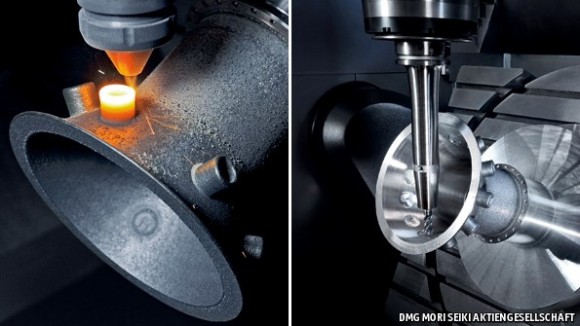 THERE are now a score or more of ways to print objects out of metal, plastic or both by building them up, layer by layer, into the finished article. But such 3D printing has its limits. One is that no version of the process is good at making the surfaces of its products smooth and accurate enough for them to be used as mechanical components: for example, as the bearings in an engine. If the necessary tolerances are not met, the engine will seize and be no good to anyone. Many engineers therefore think that “additive manufacturing”, as it is sometimes known, remains a long way from ousting traditional “subtractive manufacturing”—in other words, milling, cutting and grinding things.
THERE are now a score or more of ways to print objects out of metal, plastic or both by building them up, layer by layer, into the finished article. But such 3D printing has its limits. One is that no version of the process is good at making the surfaces of its products smooth and accurate enough for them to be used as mechanical components: for example, as the bearings in an engine. If the necessary tolerances are not met, the engine will seize and be no good to anyone. Many engineers therefore think that “additive manufacturing”, as it is sometimes known, remains a long way from ousting traditional “subtractive manufacturing”—in other words, milling, cutting and grinding things.
The Lasertec 65 Additive Manufacturing machine, though, is the start of an approach that might change the traditionalists’ minds. It is a hulking device which, on the outside at least, resembles a large industrial refrigerator (the 65 refers to the 650mm height of the internal chamber in which things can be built). But that belies the sophistication of its interior. For though it can indeed, as its name suggests, do additive manufacturing, it can also subtract, if required. A prototype of this new, hybrid device was unveiled at the Euromold engineering show in Frankfurt in December by its creator, DMG Mori Seiki, a machine-tool firm based jointly in Germany and Japan. The Lasertec will go on sale in 2014, it is expected at more than $500,000 a pop.
That price tag demonstrates two things. The first is that machine-tool makers are beginning to recognise 3D printing is going to be important in the factory of the future, not just for making models and prototypes (as is already happening) but also finished goods. The second is that additive manufacturing can complement subtractive manufacturing, as well as compete with it. If it work—and sells—the Lasertec could be the first of many such hybrids.
This particular machine builds material up using a process called laser-deposition welding. That involves spraying a fine jet of powdered metal through a nozzle and into a laser beam, which melts both the powder and the surface of the piece being worked on, welding the two together. (A sheath of inert gas surrounding the nozzle stops the molten material oxidising.) By repeating the process, layers of material can be built up. The company claims it can do this 20 times faster than is possible by using a laser to melt successive layers of powder spread onto a flat bed in the process called laser sintering, which is now the most common way metal items are 3D-printed.
Once the newly built structure has cooled, it can be machined. This happens in the same chamber, using a conventional cutting tool. The device can change tools automatically, in order to create the required shape and finish. Moreover, during both welding and machining the table to which the part being worked on is attached can be rotated around multiple axes, to increase the machine’s dexterity.
Subtractive manufacturing, in which a milling machine cuts shapes from metal blocks, may waste as much as 95% of the original material. By building something additively, even to only approximately the right shape, and then milling it, such wastage, the company reckons, can be reduced to around 5%.
Moreover, the object can be milled every time a new layer is added. This means smooth internal surfaces can be created inside what eventually becomes a solid object—something previously possible only if an item was made by joining together components that had been milled separately. With its ability to add and remove materials that include aluminium, brass, copper, stainless steel and numerous alloys, the hybrid Lasertec can also be used to repair items that are worn, or even broken. A case, perhaps, of old and new technologies coming together to produce more than the sum of their parts.
Read more here.
